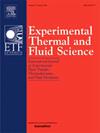在不同壁面热条件下,不同涂层受热表面上水滴的蒸发特性
IF 2.8
2区 工程技术
Q2 ENGINEERING, MECHANICAL
Experimental Thermal and Fluid Science
Pub Date : 2024-10-14
DOI:10.1016/j.expthermflusci.2024.111335
引用次数: 0
摘要
防冰系统是确保飞机安全的关键子系统。在飞行过程中,飞机表面经常会有水滴蒸发。研究水滴蒸发的特性对于设计有效的主动或被动飞机防冰系统至关重要。以往的研究主要集中在恒定壁温条件下的小水滴蒸发。随着更多电动飞机的出现,电加热防冰系统开始被采用,这些系统通常在恒定的壁面热通量条件下运行。尽管出现了这种转变,但对不同表面特性和恒定壁面热通量条件下蒸发的定量特征还没有进行深入研究。本文建立了一个实验测试场,研究不同涂层的加热表面在不同壁面热条件下的水滴蒸发特性。实验结果表明,水滴在疏水表面上的蒸发时间比在亲水表面上的蒸发时间长。当表面温度从 40 °C 升至 80 °C 时,蒸发时间增加了 5 至 13 倍。此外,在恒温条件下,小液滴和大液滴蒸发时间的差异比恒定热通量条件下的差异更为明显。对于抛光铝和亲水表面上的液滴,蒸发速率与蒸发表面积呈线性关系。这项研究的结果可为今后防冰系统的优化提供参考。本文章由计算机程序翻译,如有差异,请以英文原文为准。
Evaporation characteristics of water droplets on heated surfaces with various coatings and under different wall thermal conditions
The anti-ice system is a crucial subsystem for ensuring aircraft safety. Water droplet evaporation on its surface is a frequent occurrence during flight. Investigating the characteristics of water droplet evaporation is essential for designing effective active or passive aircraft anti-ice systems. Previous research has primarily focused on the evaporation of small droplets under constant wall temperature conditions. The emergence of more electric aircraft has led to the adoption of electrical heating anti-ice systems, which typically operate under conditions of constant wall heat flux. Despite this shift, the quantitative characteristics of evaporation under different surface properties and constant wall heat flux conditions have not been thoroughly investigated. In this paper, an experimental test site was built to study the evaporation characteristics of water droplets on heating surfaces with various coatings and under different wall thermal conditions. The experimental results showed that the evaporation time for droplets on hydrophobic surfaces was longer than that on hydrophilic surfaces. The increase in evaporation time ranged from 5 to 13 times as the surface temperature was raised from 40 °C to 80 °C. Furthermore, the difference in evaporation time between small and large droplets was more pronounced under constant temperature conditions than that of constant heat flux conditions. For droplets on polished aluminum and hydrophilic surfaces, the evaporation rate was linearly related to the evaporation surface area. The findings of this study can inform future optimizations of anti-ice systems.
求助全文
通过发布文献求助,成功后即可免费获取论文全文。
去求助
来源期刊

Experimental Thermal and Fluid Science
工程技术-工程:机械
CiteScore
6.70
自引率
3.10%
发文量
159
审稿时长
34 days
期刊介绍:
Experimental Thermal and Fluid Science provides a forum for research emphasizing experimental work that enhances fundamental understanding of heat transfer, thermodynamics, and fluid mechanics. In addition to the principal areas of research, the journal covers research results in related fields, including combined heat and mass transfer, flows with phase transition, micro- and nano-scale systems, multiphase flow, combustion, radiative transfer, porous media, cryogenics, turbulence, and novel experimental techniques.
 求助内容:
求助内容: 应助结果提醒方式:
应助结果提醒方式:


